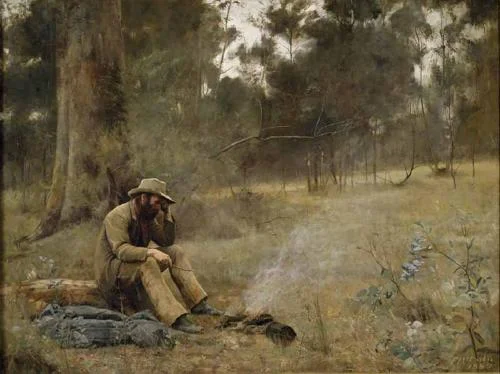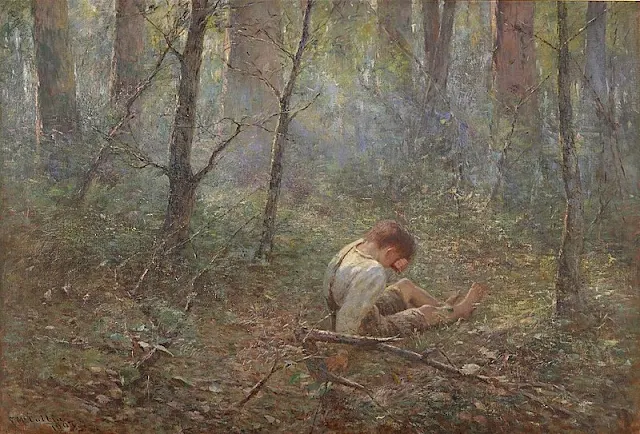Frederick McCubbin, born on February 25, 1855, in Melbourne, Australia, stands as a monumental figure in the realm of Australian art. Renowned for his pivotal role in the Heidelberg School, an influential movement that embraced the principles of Impressionism, McCubbin's work captures the essence of the Australian landscape and its pioneering spirit. His artistic journey began in his youth, where a passion for drawing led him to pursue formal training at the National Gallery of Victoria Art School.
McCubbin's dedication to portraying uniquely Australian themes—ranging from serene bush landscapes to poignant narratives of settler life—has left an indelible mark on the country's artistic heritage. His notable works, such as "Down on His Luck" and "The Pioneer," not only reflect his mastery of light and color but also resonate with the national identity that emerged in Australia during his lifetime. As we explore McCubbin's life and legacy, we delve into the artistry that made him one of Australia's most celebrated painters, whose influence continues to inspire generations of artists today.

Frederick McCubbin Self-portrait, 1886
McCubbin's paintings by and large focused at the Australian landscape and regular life, frequently depicting scenes from rural regions and pioneer groups.
Down on His Luck, 1889
Violet and Gold, 1911
Concerned with capturing the national life of Australia, McCubbin produced a number of large landscapes that reflect the melancholic themes then popular in literary accounts of European settlers' interactions with the bush. Several of these works have become icons of Australian art, including Down on His Luck (1889), On the Wallaby Track (1896) and The Pioneer (1904).
The Pioneer, 1904
McCubbin studied at the National Gallery of Victoria Art School under a number of artists, notably Eugene von Guerard and later George Folingsby. One of his former classmates, Tom Roberts, returned from art training in Europe in 1885, and that summer they established the Box Hill artists' camp, where they were joined by Arthur Streeton and Charles Conder.
On the Wallaby Track, 1896
Setting Sun, 1911
McCubbin was born in Melbourne and was educated at William Willmett's West Melbourne Common School and St Paul's School, Swanston Street. He later worked for a time as solicitor's clerk, a coach painter and in his family's bakery business while studying art at the National Gallery of Victoria's School of Design, where he met Tom Roberts and studied under Eugene von Guerard.
Lost, 1886
By the early 1880s, McCubbin's work began to attract considerable attention and won a number of prizes from the National Gallery, including a first prize in 1883 in their annual student exhibition.
Lost, 1907
In 1888, he became instructor and master of the School of Design at the National Gallery. In this position he taught a number of students who themselves became prominent Australian artists, including Charles Conder and Arthur Streeton.
Mary, 1891
McCubbin was exhibiting and perhaps painting in the studio of his friend Tom Roberts in the Grosvenor Chambers in Collins St by May 1888. His son, Louis, would later have a studio in the same building.
Princes Bridge, 1908
In 1901 McCubbin and his family moved to Mount Macedon, transporting a prefabricated English style home up onto the northern slopes of the mountain which they named Fontainebleau. It was in this beautiful setting, in 1904, that he painted The Pioneer, amongst many other works, and this is the only place that McCubbin ever painted fairies.
The North Wind, 1888
McCubbin continued to paint through the first two decades of the 20th century, though by the beginning of World War I his health began to fail. In 1912 he became the founding member of the Australian Art Association. McCubbin died in 1917 from a heart attack.
"McCubbin creates an engulfing, claustrophobic landscape by barely suggesting any horizon and compressing midground and background. In contrast, the bush folk are portrayed as heroic figures."
The Letter, 1884
The letter depicts a young woman reading a letter walking in the bush alongside a stream.
The model for the woman was the artist's sister Harriet McCubbin (known as "Polly"), an art student. The setting is believed to have been worked up from en plein air sketches of the Yarra River near Darebin Creek.
Bush Idyll, 1893
In 1998 McCubbin's painting Bush Idyll (1893) sold for $2,312,500, widely considered to be amongst the finest paintings in Australian art history. Bush Idyll is a captivating exploration of youth and nature, painted in 1893 during a pivotal moment in Australian art history.
This masterpiece, housed in a private collection, depicts a serene scene where a girl and a boy, the latter playing a tin whistle, are depicted lying on the ground near Blackburn Lake. The painting not only showcases McCubbin's mastery of oil on canvas but also reflects the idyllic beauty of the Australian bush, encapsulating the innocence and promise of childhood against the backdrop of a pre-Federated nation.
An Old Politician, 1879
McCubbin's painting "An Old Politician" serves as a poignant reflection of the complexities of political life in 19th-century Australia. This artwork captures a moment of introspection, showcasing an elderly politician deep in thought, perhaps contemplating the weight of his decisions and the passage of time.
On 22 March 2016, the painting resurfaced from a private vault in an Australian bank. The painting has not been viewed in public exhibition since its sale to a private collector in the 1880s.






















